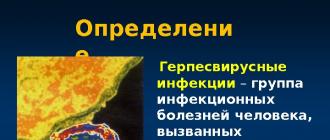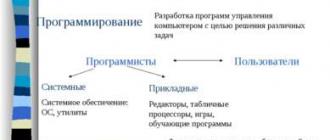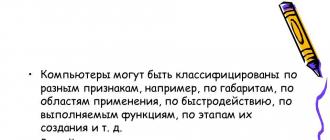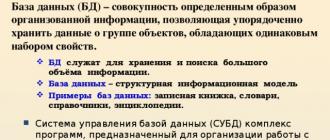The presentation "Classification of modern computers" was made in MS PowerPoint 2003 and allows you to systematize the knowledge about the currently used terms to denote the varieties of modern computers. All terms are given with explanations and an image is assigned to each term (name).
Download:
Preview:
To use the preview of presentations, create yourself a Google account (account) and log into it: https://accounts.google.com
Slide captions:
Classification of modern computers Developed by: teacher of computer science Isupov S. L. Izhevsk 2014 Ministry of Education and Science of the Udmurt Republic MBOU "Secondary School No. 59"
Personal computers Servers Supercomputers
Personal computers Stationary Portable Subnotebooks Laptops Netbooks Ultrabooks Tablets Desktops Nettops Monoblocks Smartbooks
Desktop A desktop computer is a stationary personal computer designed to work in the office or at home.
Nettop Nettop (English nettop) is a desktop personal computer, small in size of its system unit. The term ″ Nettop ″ is derived from ″ InterNET ″ and ″ deskTOP ″. It is used in conjunction with the server and when using ″ cloud ″ technologies.
Monoblock Monoblock (Greek μονος - one) - combines a monitor and a system unit in one case, is used to reduce the area occupied by the equipment and give a more aesthetic appearance.
Laptop Notebook (English notebook - notebook) or laptop (English lap - knees, top - top) - a portable personal computer, in the case of which a display, keyboard and pointing device (usually a touch panel, or touchpad), as well as rechargeable batteries are combined ...
Netbook Netbook (English Netbook, net - network, book - book) - a laptop with a relatively low performance, designed mainly for Internet access. It has a small screen diagonal of 7-12 inches, low power consumption, light weight and relatively low cost.
Subnotebook A subnotebook, or ultraportable, is small and lightweight and has most of the characteristics of a conventional laptop.
Ultrabook The Ultrabook is an ultra-thin and light subnotebook that is even smaller and lighter than conventional notebooks, but still has many of the characteristics of a full-fledged notebook.
Smartbook Smartbook (English Smartbook from smart phone - smart phone and note book - notebook) or PDA (Pocket PC) - a small laptop built on a hardware platform of the same class that is used for smartphones and tablet computers.
Tablet Tablet computer (English Tablet computer or electronic tablet) is a collective concept that includes various types of mobile devices with a touch screen. You can control your tablet computer by touching your hand or stylus.
Server A server is a computer allocated from a group of personal computers to perform a service task without direct human participation. Distinguish between a workgroup server, a domain controller server, a web server, an e-mail server, a file server, etc.
Supercomputer Modern supercomputers are a large number of high-performance server computers connected to each other by a local high-speed backbone to achieve maximum performance. Supercomputer "Lomonosov", built by the company "T-Platforms" for the Moscow State University named after M.V. Lomonosov.
In addition to the above, there are also various hybrid devices.
On the subject: methodological developments, presentations and notes
Classification of modern educational technologies
1. On the question of defining the concepts of "teaching technology", "teaching method", "form of education", "pedagogical technique", etc. 2. To the problem of classification of "methods" and "forms" of teaching. 3. Specific ...
Computer classification
Topic: "Classification of computers by functionality" Section of the program: Information technology hardware Type of lesson: learning new material Objectives: 1. ...
http://www.mkgt.ru/files/material-static/138/contents.htm
PC and workstations
Servers
Mainframes
Cluster architectures
To software terminology
Program
Software
Software tool
Software package
A program is a complete product suitable for launch by its author on the system on which it was developed.
Software - a program that anyone can run, test, fix and develop. Such a program should be written in a generalized style, thoroughly tested, and accompanied by detailed documentation.
Such definitions are located, for example, at http://mf.grsu.by/Kafedry/kaf001/academic_process/048/28
SUMMARY OF THE REVIEW LECTURE.For students of the specialty
Т1002 "Software of information technologies" (A.M. Kadan, Ph.D., associate professor)
Software tool is a program or a logically related set of programs on storage media, provided with program documentation.
Software package - a set of interacting programs, consistent in functions and formats, precisely defined interfaces, and together they make up a complete tool for solving large problems.
GOST 19781-90 PROVIDING INFORMATION PROCESSING SYSTEMS SOFTWARE Terms and definitions
Software of data processing systems. Terms and definitions
Program (Program) - data intended to control specific components of the information processing system in order to implement a specific algorithm
Program (en program): - see GOST 19781.
Software product (en software product): A software product intended to deliver,
transfer, sale to the user.
GOST 28806-90 SOFTWARE QUALITY Terms and definitions
Software quality. Terms and definitions
Software tool; PS (en software):
An object consisting of programs, procedures, rules, as well as, if provided, accompanying documentation and data related to the functioning of the information processing system.
Note. A software tool is a specific information that objectively exists as a set of all properties that are significant from the point of view of its presentation of each of the material objects containing this information in a fixed form.
Glossary (glossary.ru)
Software product- a program or a logically related set of programs:
- recorded on data carriers;
- which is a product of industrial production;
- supplied with software documentation;
Intended for wide distribution through sale or by freeware, shareware or OEM methods.
Software package- a set of interacting programs:
- coordinated in functions and formats;
- having uniform, well-defined interfaces; constituting a complete tool for solving large problems.
Computers can be classified according to various criteria, for example, by size, by areas of application, by speed, by functions performed, by stages of their creation, etc. In this presentation, we will consider the classification by a generalized criterion, where several characteristic features:




Parameters Large computers Small computers Performance (million op / s) 1000 - RAM size (MB) External memory size (GB), Bit depth (bit) 64; 12816; 32; 64


SERVERS A SERVER is a powerful computer used in computer networks, which provides servicing of computers connected to it and access to other networks. The server stores large amounts of information that are used by other computers connected to it. The server has increased requirements for speed and reliability. It should provide for the possibility of backing up all stored information. Maintenance and repair work should be carried out without stopping it and turning off other computers.












CHARACTERISTICS "User-friendliness" of the interface of human-computer interaction Low cost Small dimensions Open architecture Large number of software tools for various fields of application Compatibility of new versions and models High operational reliability

Generalized characteristics of personal computers Parameters Microprocessor type Pentium Pentium Pro Clock speed (MHz) 60 - - 600 RAM size (MB) 8, 16, 32 16, 32, 64, 128 Hard disk size (GB) 1 - 102 - 16 Cache size memory (KB) 512, 1024, 2048 Bit depth 32
 PORTABLE COMPUTER The name comes from the Latin porto - "wear" and means that they are easy to carry from place to place. Their weight ranges from 0.2 to 6 kg. Usually they are designed in the form of suitcases or folders and, in turn, are divided into several types: 1. laptop 2. organizer - an electronic notebook
PORTABLE COMPUTER The name comes from the Latin porto - "wear" and means that they are easy to carry from place to place. Their weight ranges from 0.2 to 6 kg. Usually they are designed in the form of suitcases or folders and, in turn, are divided into several types: 1. laptop 2. organizer - an electronic notebook

 Designed for use in industrial environments. They are built into the technological process of the production of any product, they control the technological lines and machine tools. With their help, they control airplanes, trains, conduct research and test new instruments, mechanisms, devices. They are subject to increased requirements for reliability of operation, resistance to various fluctuations in environmental parameters (temperature, vibration, dust, etc.)
Designed for use in industrial environments. They are built into the technological process of the production of any product, they control the technological lines and machine tools. With their help, they control airplanes, trains, conduct research and test new instruments, mechanisms, devices. They are subject to increased requirements for reliability of operation, resistance to various fluctuations in environmental parameters (temperature, vibration, dust, etc.)

Test questions and tasks 1. Describe the class of personal computers. 2. Give the main characteristics of the personal computer. 3. What characteristics of the laptop are essential for the user and why? 4. What influences the price of a computer the most? 5. What characteristics of laptop computers do you know? 6. Tell us about the purpose of organizers and laptops. 7. How do you imagine an industrial computer?

Slide 2
All computers are divided into large and small
The class of large computers is made up of systems that have great computing power and are designed to serve multiple users at the same time. In turn, small computers are designed to help a person in their daily work with current information.
Slide 3
Large computers are divided into
Supercomputers - possessing enormous computing power, based on the multiprocessor principle of information processing. As a rule, such machines are produced in single copies and are used in areas where fast analysis of large flows of information is required.
Slide 4
Servers are powerful computers in computer networks that maintain the computers connected to them, provide their resources for use by other users and provide access to other networks. Servers often specialize in serving workstations in a specific area. Depending on the purpose, the following types of servers are determined: application server, file server, archive server, fax server, mail server, print server, teleconference server.
Slide 5
Small computers are classified into
Personal. The main purpose is to perform routine work: searching for information, drawing up standard forms of documentation, preparing texts of various kinds, etc. The general availability and versatility of personal computers is ensured by the presence of the following characteristics: user-friendliness of the interface for interacting with a person, low cost, small dimensions and the absence of special requirements for environmental conditions, open architecture, a large number of software tools for various fields of application, high reliability.
Slide 6
Portable. These computers are easily portable. They are often designed as suitcases or folders.
Slide 7
Manufacturing. Designed for use in industrial environments. They are built into the technological process of the production of any product, they control the technological lines and machine tools.
Slide 8
- In addition to the indicated capabilities of the computer, a number of other parameters are characterized by the bit depth and form of representation of numbers;
- external memory capacity;
- characteristics of external storage devices, exchange and input-output of information;
- throughput of communication devices of computer nodes among themselves;
- the ability of a computer to work simultaneously with several users and run several programs at the same time;
- the types of operating systems used on the machine;
- software compatibility with other types of computers, that is, the ability to execute programs written for other types of computers;
- the ability to connect to communication channels and to a computer network;
- reliability, etc.
View all slides





